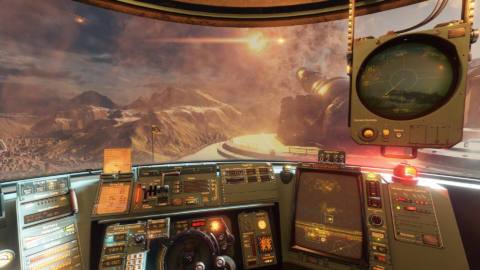What is it? A singleplayer first-person driving survival game with maybe the best car ever
Expect to pay: $30/£25
Developer: Ironwood Studios
Reviewed on: Intel i7-9700K, RTX 4070 Ti, 16GB RAM
Multiplayer? Nope.
Link: Official site
With sincere apologies to the Magnum Opus from Mad Max, the Saud Kruger Orca passenger liner from Elite Dangerous, and Arthur Morgan's horse, I have a new favorite ride: the station wagon in Pacific Drive.
It didn't look like much at first: just a typical late '80s family wagon with wood paneling and a hatchback trunk. But over the course of the last 35 hours I've turned it into an armor-plated, radiation-resistant tank positively bristling with sci-fi gadgets. And it's only a little bit haunted.
Those upgrades (and those ghosts in the shell) are the result of barreling through a hellscape of nightmarish weather, crumbling roads, and more horrifying anomalies per square mile than the entire Stalker trilogy combined. Pacific Drive, the debut game from developer Ironwood Studios, is a first-person driving survival game where you explore a spooky and deadly exclusion zone to gather the resources you need to soup up your ride.
I'm declaring it right now: the station wagon in Pacific Drive is one of the best vehicles in videogames, ever. Unfortunately you have to spend a lot of time leaving it behind to run around on foot, and that's where the game falters a bit. But when you're roaring through the hostile world in that glorious, ridiculous wagon, Pacific Drive puts an exciting and fresh new spin (ha ha, because tires) on the survival genre.
Joy Ride
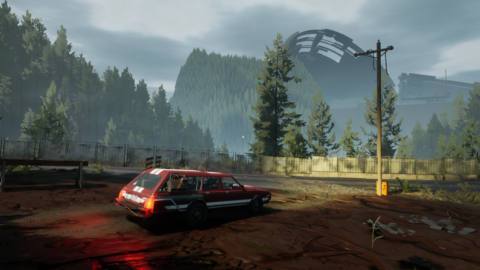
After mysterious science experiments in Washington state's heavily forested Olympic Peninsula went horribly awry, the government built a towering concrete wall around it and called it quits. Trapped inside the barricades of what's now called the Olympic Exclusion Zone, you've got nothing but your clunker, a workbench in a dimly lit garage, and the guidance of a few oddball scientists who chat to you (and each other) over the radio.
The zone isn't an open world: it's broken up into maps called junctions, with crumbling roads that wind through foggy pine forests, misty marshes, and charred hills. The only hope of escape is to explore the world one junction at a time, scavenging for supplies among the cluttered cabins, rusted car frames, and abandoned science workshops the government left behind. Back at your garage you use what you find to craft new and better car parts, research new tech, and repair any damage your wagon sustained on the journey. Most junctions will open up roads to new ones, and your map of the zone will slowly grow until you can chain together long multi-junction trips deep into the peninsula.
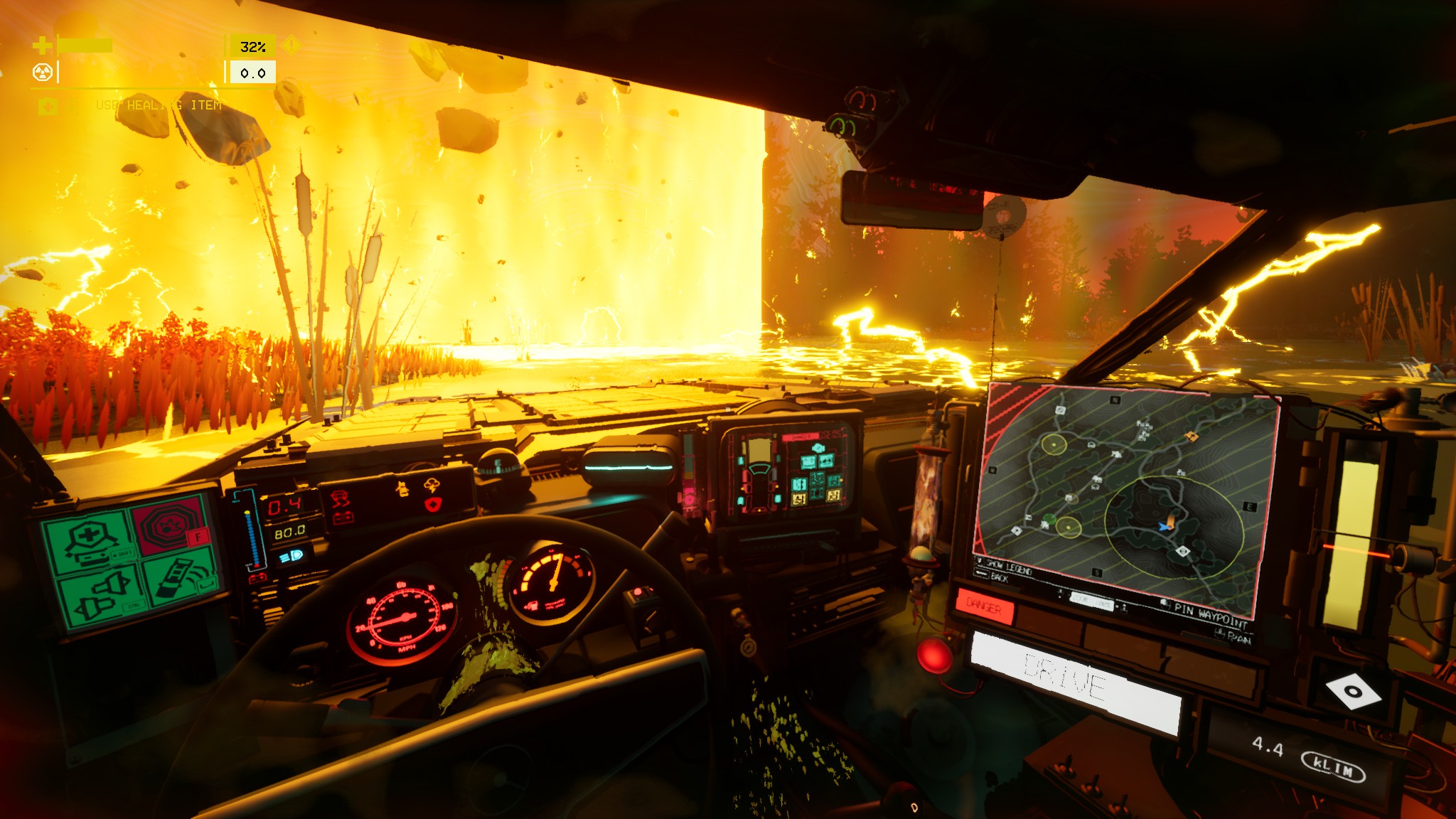
The zone, meanwhile, is furious that you're there and will do whatever it can to stop you from leaving alive. Bizarre and deadly anomalies populate these junctions, from crackling electrical entities that crawl along the ground and fry your car's electronics to massive spreading patches of deadly radiation that sap your health. Hovering mechanical monstrosities with dangling magnets yank your car off the road and drag it into the trees, while other entities will try to disassemble it completely by ripping off doors and bumpers. Tremendous weather events can arrive in moments with wind gusts so strong they'll push your car off the road, while geyser-like anomalies blast gobs of green goo into the air to rain down on you.
These aren't separate events, by the way. These things can all happen at once and it's… a lot. Sometimes it's too much and just feels frustrating. Once, in the middle of the night in a blinding storm, one of my headlights failed while the other was plucked out and stolen by a thing, just as another thing started flinging my car off the ground and into the air repeatedly. My wagon was in tatters, I was nearly out of health, so I just sat there being bounced around in pitch blackness unable to drive myself to safety—unable to even see which direction safely might be—thinking: is this fun, or just annoying?
Developer Ironwood Studios seems to even know how rough its game can get: one biome's attributes are labeled “Exhausting Explosions.” They sure were.
Praying my car’s faltering parts would hold on just a few seconds more as I careened through the trees to reach a safe exit just as a mega storm hit
That's an outlier though. Usually I found Pacific Drive a thrilling challenge, leaping out of my wagon to loot a building or peel the steel off an abandoned car, scurrying back just as a hovering menace began descending upon me, and flooring it while veering left and right to avoid spiky anomalies chewing through the ground, my dashboard bathed in sparks from an electrical blast. Gritting my teeth, praying my car's faltering parts would hold on just a few seconds more as I careened through the trees to reach a safe exit just as a mega storm hit. Exhilarating.
Irradiator fluid
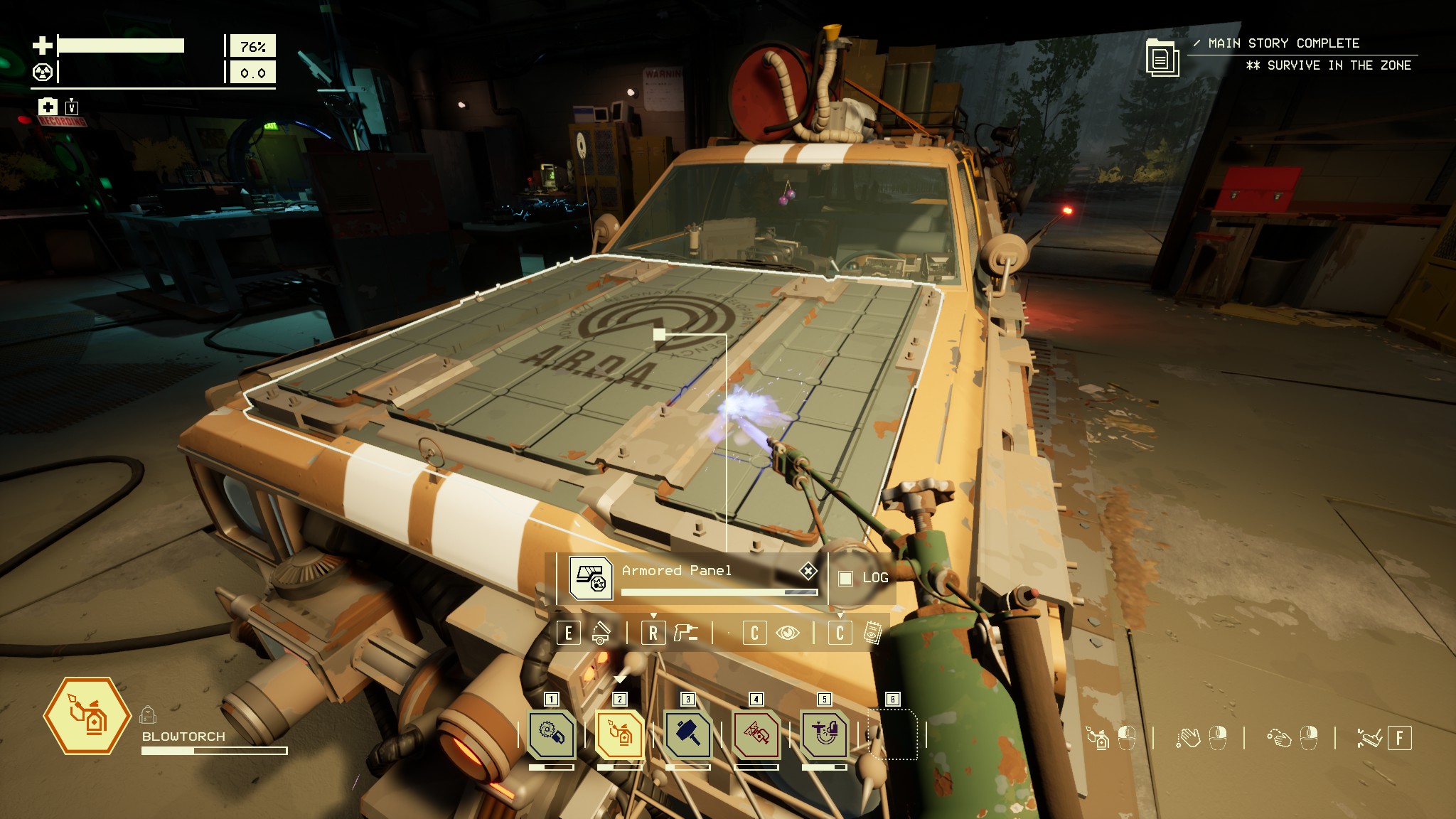
In Pacific Drive nearly all of the survival systems are focused on your car. You, the driver, have a health bar… and that's it. Your wagon, however, is a network of wonderfully modeled vital organs. Doors, panels, bumpers, windows, tires, and other parts and pieces each have their own health bar and are susceptible to physical, electrical, acid, or radiation damage, plus loads of other status effects: tires can go flat, fuel tanks can leak, batteries can short out, wheels can become loose.
And no matter how diligently you tend to your car's bumps and scrapes, over time everything slowly wears out. Just like in real life, you can patch a flat tire repeatedly but eventually it will go bald and have to be replaced. The durability system is rough, but I kinda love that components in Pacific Drive eventually die. Duct tape and a blowtorch can prolong the life of a part, but not forever. It feels fair.
What's the equivalent of eating and drinking, for cars? Gasoline and electricity, I guess, and I've done everything I can to keep my car's metal belly full of nutrition. I have a battery under the hood but also one on the roof and a third mounted in the back seat. (Somewhat alarmingly that one has begun spraying sparks, but unless it explodes I'm keeping it there.) I have two ridiculous gizmos I crafted and lashed to the sides of my car: a turbine to capture wind power, and a sci-fi gadget that somehow converts rainwater into electricity. That's science, right?

The important thing is while driving in the wind and rain (it's the Pacific Northwest, so that's almost every trip), my battery will now slowly recharge itself. One of the most satisfying moments in Pacific Drive was when I glanced at my dashboard and for the first time and saw my car battery meter slowly fill instead of troublingly drain. I'm a good car dad, I thought. I'm feeding my beautiful wagon-child.
I love this damn car.
A full battery is massively important because I've got other crafted science gizmos crammed all over my car, and they need tons of juice, including a resource radar that can pinpoint the junk I need during supply runs, which makes each excursion more of a surgical strike than a cross-my-fingers search. I have a massive floodlight mounted on the side of the car for night missions, and a device that synthesizes fuel (somehow) from the zone's weird atmosphere.
I also have a literal lifesaver: a device that heals me when I'm sitting in the driver's seat, which is much better than standing outside the car and using a health kit. Best of all, I've got a forcefield I can activate that keeps those damn hovering anomalies from grabbing parts of my car and absconding with them.
Here's an actual quote from me the first time I watched those gross monsters trying to latch onto my car with their tentacles only to bounce harmlessly off my glowing energy shield: “Ha ha ha! Suck it!”
I love this damn car.

Adorning my car with batteries and generators solves some problems but creates others. That roof battery and resource radar don't leave room for, say, a massive secondary gas tank or storage container big enough to fit a set of spare tires in. That means more time spent refueling and patching damaged wheels, which means more time standing outside with anomalies bearing down on us.
Before each trip I need to spend time thinking about which attachments will be the most useful based on what I've learned about the zone's different junctions and hazards. Like other great survival games such as Valheim and Outward, Pacific Drive gives me the enjoyment of a long pre-trip planning phase where I try to anticipate what I'll need, packing just enough to survive while still leaving room for everything I might find and bring back.
Odd in 60 seconds

Repairs aren't the only attention you have to lavish on your car: your wagon will also develop “quirks” due to exposure to the bizarre reality of the zone. My car's first quirk developed while I was in the zone in the middle of the night, already jumping in fear at every groan or creak from the woods. As I ran back to my car I noticed the passenger door was open—weird, I was pretty sure I hadn't opened it. I began getting paranoid as I noticed it open again a bit later. My mind raced: did something invisible get into the car with me?
Eventually I discovered that whenever I got out of my car the passenger door would pop open. It was a quirk, and not the last my car would contract. At one point slamming my trunk shut would make the horn honk, a noise that startled me every time it happened. Diagnosing and curing quirks is handled with a fun minigame in the garage using a terminal to pick words from four columns to form if/then statements, such as SHIFTER / IS IN DRIVE (the cause of the quirk) so HOOD / OPENS (the quirk itself). If you diagnose your quirk correctly, the computer tells you what you need to craft to fix it.

Even this cute game can be tough at times. One particular quirk tormented me for hours because whenever I was driving, the car radio would turn on and off, making a click-click sound every few seconds. I tried guess after guess at the terminal to diagnose it, until I eventually stumbled on the solution: the radio was toggled not by the car driving but the battery charging—which was the result of the car driving, thanks to all my generators. That was a single quirk solved: only five more to go.
Step on it
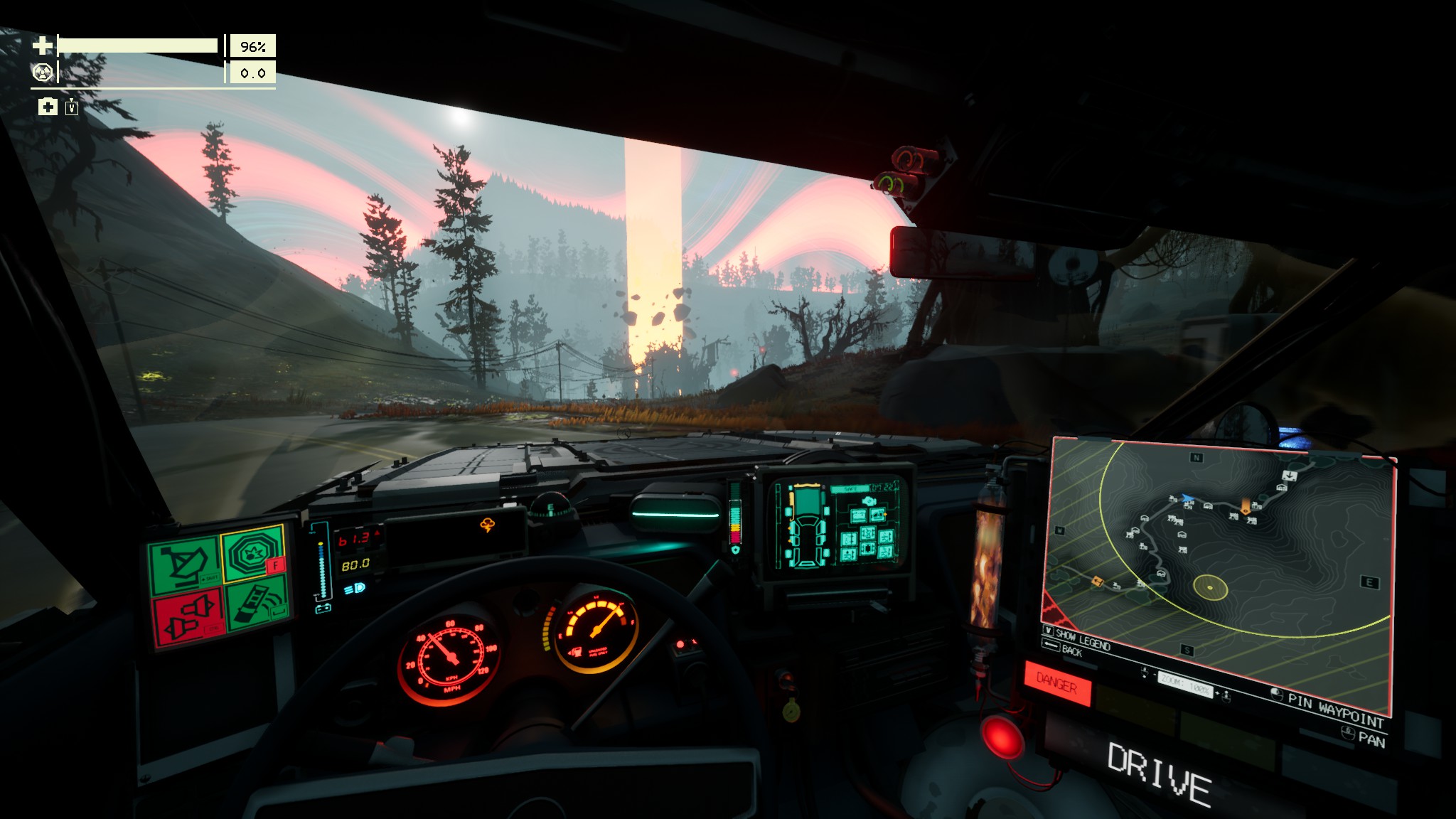
Much as I love driving my quirky car through the zone and tending to its every need in my garage, the actual act of gathering all those resources does eventually become a bit of a trudge. There's a thrill to scavenging for a while: leaving your car feels like a vulnerable, naked act as you scuttle fearfully into a building to collect junk or scrap the doors and tires off a wreck. As anomalies and storms begin closing in, adrenaline will make the act of looting a cabin feel like a frantic and fun race against the clock.
I’m always thrilled to roar back into the zone for another fruitful mission or frightful failure
But there are only so many different types of containers to search, cars to skeletonize, labs to hunt through, and cabins to plunder before it all begins to feel a bit mindless and repetitive. I occasionally wish there were more ways to generate a few much-needed items at my garage like in other survival games: maybe by growing swamp eggs in the bathroom sink or by constructing my own little plasma generator that would at least provide a handful of resources every now and then.
But then, this is a driving game, not a farming game. If I need something, I've gotta hit the road. Yes, the occasional overly-brutal zone excursion may leave me exasperated, and sometimes the resource collection tasks feel heavily repetitive, but they can't overshadow my fondness for this silly sci-fi station wagon. I'm always thrilled to roar back into the zone for another fruitful mission or frightful failure, and I'll happily spend ages in the garage repairing and replacing every single component using scrap metal, duct tape, and lots of love.


